Picuris Pueblo and Friends
Back at the Mica Mine, One Year Later

Gerald Nailor, Picuris Governor, center, talks with
Oglebay Norton representatives, right
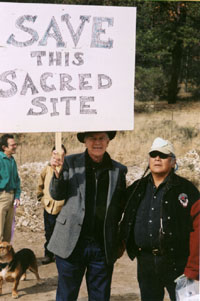
Malcolm Ebright and Richard Mermejo, Picuris War
Chief
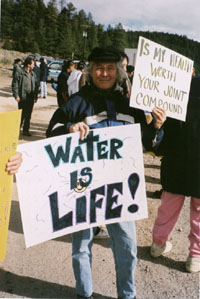
Esta Gutierrez Of Vecinos del Rio
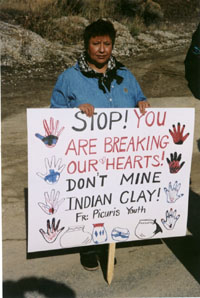
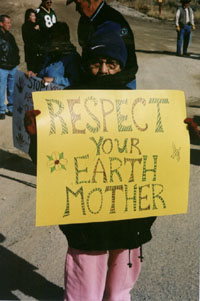
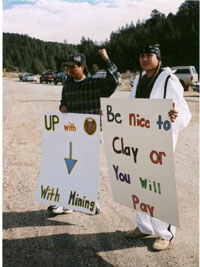
Picuris Tribal members of all ages come to show their
support
Editorial: Picuris Pueblo - No
Compromise in Defense of Mother Earth
By Mark Schiller
On November 14 Picuris Pueblo, in an effort to publicize
its concerns about the mica mining and milling operations of
Ogelbay Norton, led its second public protest (see La
Jicarita December 2001 for details about the first protest)
at the mine site on U.S. Hill and at the mill site in
Velarde. Working in conjunction with Vecinos Del Rio, a
community action organization from the Velarde area, The New
Mexico Environmental Law Center, Amigos Bravos, and
concerned individuals throughout the Rio Pueblo/Rio
Embudo/Rio Grande watershed, the Pueblo is demanding that
Oglebay Norton cease the mining and milling operations that
have destroyed the Pueblo's ancestral clay pits and degraded
air and water quality throughout the area.
During the protest several officials from Oglebay Norton
approached Pueblo Governor Gerald Nailor to acknowledge that
the mine and milling sites "haven't been managed well." They
attempted to assure the Governor that those responsible had
been fired and that the company is "going to do whatever it
takes to bring this facility into compliance." This last
statement refers to a Notice Of Violation recently issued by
the New Mexico Energy, Minerals and Natural Resources
Department which cited Oglebay Norton for:
1) Failure to obtain an approved permit modification or
revision to allow use of Holder #9 waste unit for deposition
of sand tailings.
2) Failure to minimize negative impacts to the hydrologic
balance in both the permit and potentially affected
areas.
3) Failure to construct and maintain stockpiles to
minimize mass movement. This failure caused disturbance on a
previously undisturbed area outside the approved design
limits of the mine.
4) Failure to reclaim disturbed lands in a manner that
controls erosion.
The Governor, however, told the group of protesters that
the Pueblo is not interested in negotiating with Ogelbay
Norton and intends to proceed with its efforts to have the
mine shut down and the land reclaimed. He went on to say
that the mining and milling operation threaten "not only our
resources but our lifestyle, which is based on hundreds of
years of culture and tradition." War Chief Richard Mermejo
amplified on the Governor's comments, saying the mining and
milling operations "are destroying Mother Earth just to
increase the jingle in a few greedy peoples' pockets. As
warriors and the sons and daughters of Mother Earth, we will
not allow this to happen." Donna House, President of Vecinos
del Rio, then told the protesters that Oglebay Norton is
"poisoning our air and our water." She explained that people
living adjacent to the mill site are concerned about
breathing the dust from the milling operation, which also
covers their homes, their cars, their acequias, and their
crops.
This continuing demonstration of community solidarity and
empowerment is enormously important, and I'd like to use it
to make a couple of points. First, we all owe an enormous
debt of gratitude to Picuris Pueblo for having the courage
and perseverance to take on the "big issues" such as the
mica mine. This is not the first time Picuris has led the
fight to check inappropriate development in the Jicarita
watershed. The Pueblo led the successful fight to stop
mining in the Copper Hill area. They also led the fight to
prevent ski area development that could adversely affect the
environment and the rural/agricultural life of our
traditional communities. They have implemented water quality
standards to protect our most precious resource and are
currently developing strategies to mitigate pollution from
septic tanks in the Rio Pueblo alluvium. Working in
conjunction with the New Mexico Environmental Law Center,
which has helped the Pueblo voice its concerns in the courts
and before regulatory agencies, Picuris has demonstrated
that they are, indeed, formidable warriors who will not
compromise their land-based values. While both
demonstrations against the mining on U.S. Hill have been
well attended and effective, it is high time that more
community members demonstrate their support of the Pueblo by
turning out in hundreds rather than dozens. You can also
help by making a tax deductible contribution to the New
Mexico Environmental Law Center, 1405 Luisa St. # 5, Santa
Fe, N.M. 87505.
Second, many outside interests besides Oglebay Norton
stand ready to continue the exploitation of our remaining
forest, mineral, water, and cultural resources. Recreational
development, tourism, real estate development, thirsty
municipalities, and industry all threaten the
rural/agricultural base of northern New Mexico. If we do not
organize and speak with one loud, politically powerful
voice, these remaining resources will be misappropriated
just as the land grants were. This means looking beyond the
issue of race which continues to divide us. This means
looking beyond the petty internecine battles that plague all
of our communities. Politicians, as we all know, are
primarily concerned with one issue: getting reelected. Over
the past few years several so called "community based"
organizations have tried to lobby the state legislature and
the congressional delegation on resource issues without
doing the kind of community outreach that demonstrates they
have the unified support and power to influence elections.
They've been ineffective. If we have any real hope of
influencing the political process regarding the management
of natural resoures to benefit rural communities, we must
first take on the arduous task of educating and organizing
at a grassroots level. Let's not continue putting the cart
before the horse.

Carl Tsosie reading La Jicarita News at the
demonstration
ANNOUNCEMENTS
The second annual Quivira Coalition conference, Ranching
at the Crossroads: Forging a West that Works, will be held
January 16-18, 2003 in Albuquerque. Speakers including Bill
McDonald of the Malpai Borderlands Group, Lani Lamming of
Ewe4ic, Craig Allen of the USGS, Kris Havstad of the Jornada
Experimental Range, and Gary Paul Nabhan of Northern Arizona
University will address topics of land restoration,
ranchland ecosystems, community and cultural collaboration,
and self sufficient ranching. Special events include:
opening evening guest speaker Paul Starrs, Professor of
Geography at the University of Nevada, Reno and author of
Let the Cowboy Ride: Cattle Ranching in the American West; a
book signing and autograph session with Daniel Kemmis, Gary
Paul Nabhan, Rick Knight, Nathan Sayre, Jo Robinson, and Guy
McPherson; a talk by rancher Sid Goodloe called "Reality
Ranching - Trail Drives to the New Millennium"; and a
Saturday evening banquet with speaker Jo Robinson, New York
Times bestselling author of Why Grassfed is Best! The
conference will be held at the Albuquerque Hilton at 1901
University Blvd. NE. The fee is $50 for Quivira Coalition
Members and $65 for non-members, with a special student rate
of $30. Registration forms and fees are due on or by January
2, 2003. Contact the Quivira Coalition at 505 820-2544 or by
e-mail at projects@quiviracoalition. org to sign up.
• The Taos Soil & Water Conservation District
announced that current board members Maureen Johnson and
Edward Grant were reelected to new board of supervisor terms
in the November 26 voting. Officers for the new board will
be elected at the annual meeting and potluck on Friday,
December 6, 2002 from 6 to 8 pm at the Juan I. Gonzales
Agricultural Building, 202 Chamisa Road. The meeting is an
opportunity for local land owners to learn about
conservation issues, district programs, and upcoming events.
If you would like to attend, RSVP the district office at
505-751-0584.
• Don't forget the upcoming New Mexico Organic
Farming and Gardening Expo 2003 on February 7 and 8 in
Glorieta, New Mexico. Sponsored by the New Mexico Organic
Commodities Commission and The Farm Connection, this year's
expo will feature Wes Jackson, founder of The Land Institute
and author of New Roots for Agriculture and Meeting the
Expectations of the Land (edited with Wendell Berry and
Bruce Coleman), and Deborah Madison, noted chef, author, and
slow-food advocate. The expo also offers educational
workshops, a large vendor hall, and delicious organic food.
For more information call: 505 266-9849 or e-mail
joan.quinn@state.nm.us.
|
Editorial: The Forest
Service Fiddles While the West Burns
By Kay Matthews and Mark Schiller
A recent full-page ad in the November 11 Albuquerque
Journal, signed by dozens of New Mexico county commissioners
and state legislators, petitioned Ann Veneman, Secretary of
the Department of Agriculture, to transfer jurisdiction of
national forest lands that are in "imminent" danger of
catastrophic fire to the state of New Mexico. The petition
cites Section 2268 of U.S.C. Title VII, which allows the
Secretary to relinquish to a state the legislative
jurisdiction over federal lands when necessary. It is a
follow-up action to the passage of last year's New Mexico
Senate Bill 1, which authorized county commissioners to take
the necessary actions to prevent "death, harm, or
destruction" that might result from catastrophic forest
fires. Veneman's transfer of these lands to state
jurisdiction would make Senate Bill 1 constitutional.
According to the spokesman for the ad, Albuquerque attorney
Clifford Nichols, the petitioners want to make it clear to
the federal government that it will be held liable, just as
it was in the Cerro Grande fire that was ignited by national
park employees, if it does not take the necessary actions to
protect its citizens and their property from the risk of
catastrophic fire.
This is the latest skirmish in a battle being waged
throughout the west to amend the National Environmental
Policy Act (NEPA), the Endangered Species Act (ESA), the
National Forest Management Act (NFMA) and other federal laws
that some people think have created the "analysis paralysis"
of public lands management. As everyone knows, millions of
acres of national forest lands are in dire need of thinning
and prescribed burning to restore their ecological integrity
and protect forest dependent communities. While the federal
government has allocated millions of dollars for restoration
work in New Mexico, very few acres have actually been
treated. Is this the result of burdensome environmental
regulations like NEPA or is this the fault of an
incompetent, overly bureaucratic Forest Service? We believe
it is both.
Three recent restoration and timber projects in northern
New Mexico illustrate why both environmental regulations and
the Forest Service need streamlining. First, let's talk
about the Santa Fe Municipal Watershed Project. This
watershed is acknowledged as one of the highest priority
wildland/urban interface areas in the country. The project
proposes to protect the watershed from a high severity fire
that could "decimate the watershed, threaten the city with
loss of homes and businesses, cause massive soil and debris
flows into the Santa Fe River and its water supply
reservoirs, and send muddy flood waters through Santa Fe's
streets and downtown areas." If any restoration project is
worthy of immediate action, this is it. However, this
project was appealed by Wild Watershed, Santa Fe Forest
Watch, and Forest Conservation Council on the grounds that
wildlife indicator species were not sufficiently surveyed.
This means that when the need for immediate action had been
acknowledged by an overwhelming majority of experts, a small
group of environmentalists argued that in addition to
ensuring enough habitat will be protected, time consuming
surveys of wildlife populations should be undertaken to
comply with NFMA. This appeal was dismissed by the Regional
Office of the Forest Service, and in our opinion, was an
egregious abuse of environmental regulations. Critical
projects such as this one, where potential catastrophic
damage is imminent and consensus among the majority of
stakeholders is present, warrant the streamlining of the
regulatory process. This doesn't mean it should be done
under the radar screen or attached as a rider provision to a
major bill, as Senator Tom Daschle did in his home state of
South Dakota. There need to be federal guidelines which
determine the parameters whereby local governments are
empowered to expedite these projects.
But it is not only an appeal that has delayed the start
of this project. The Forest Service awarded the contract to
a Montana-based operator because of the requirement in the
Environmental Impact Statement that most of the thinning be
done by a feller buncher, an enormously expensive piece of
equipment that no local or state-based operators own. The
use of a feller buncher may in fact have a more negative
impact upon the land than mechanical thinning with chainsaws
and denies locally-based companies an opportunity to keep
federal dollars in the state. The Forest Service required
the use of a feller buncher because it "can do as much
thinning in a day as eight men with chainsaws." Ironically,
the project has been delayed yet again because the Montana
operator is still trying to complete a project in Colorado
and probably will not begin work in the watershed until next
year. Moreover, the Forest Service capitulated to wealthy
homeowners adjacent to the watershed who objected to trucks
hauling logs through their neighborhoods. This means that
all thinned material will be left on the ground to be burned
at a future date, increasing the fire danger and further
denying local operators the opportunity to sell the
resource. In a test area that was thinned and burned in 2001
by the Forest Service, consumption of trees over three
inches in diameter
Thousands March for Peace in Taos
By Aspen Meleski, age 14
On October 26th on an overcast day people from Taos,
surrounding areas, and out of state gathered to take part in
a peace rally and march which would take them to the home of
Donald Rumsfeld, US Secretary of Defense.
The highway was lined with vehicles and cars were in
every available parking space. A crowd gathered in a field
near the Old Blinking Light and a stage had been set up on a
flatbed truck. Protesters milled around during speeches by
novelist John Nichols, Richard Deertrack of Taos Pueblo, and
Taos mayor Fred Peralta.
Immediately after the speeches, the protesters started
off towards Donald Rumsfeld's El Prado home (a 1.1 mile
walk). The line of people was impressive as it inched along
the highway, crossing once with the help of friendly State
Police officers. The signs and flags were brightly colored
with witty and heartfelt messages: Peace not Grease; Stop
the Killing Machine; Turn off your Car; and many more.
The array of protesters was a surprise, ranging from
babies to grandmas, from "hippies" to "professors" and
included bicyclists, horses, dogs, several people in
wheelchairs, and even two stilt-walkers (faces painted like
skulls, long black pants to the ground) towered above
us.
At Donald Rumsfeld's modest pink adobe, which was guarded
by Secret Service agents as well as State Police, the head
of the crowd (his narrow dirt lane squeezed us into a
"snake") clustered at his front gate, where a list of
citations against him was read and taped to the gate. As the
people filed back down his drive they were asked to leave
their signs in the barbed wire fence which bordered the lane
on both sides. At the highway the crowd dispersed and my
friends and I walked back to our car alone.
Remembering . . . the mood had been hopeful and friendly,
with so many smiling faces and laughs. All in all, it had
been a beautiful day.
And the rain began to fall!

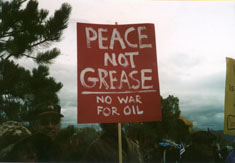

Saving the McCarthy Ranch
By Kay Matthews
Described as"Taos's last great grasslands," the McCarthy
Ranch sits between Upper Ranchitos Road and State Highway
240. A working cattle ranch that has been in the McCarthy
family for many years, 170 acres of the ranch are now up for
sale to settle the family estate. When neighbors first heard
about the sale a year and a half ago they formed Friends of
the McCarthy Ranch to see what they could do about raising
the asking price of $2.5 million to preserve what they
describe as "the largest uninterrupted expanse of pastures
left in Taos: 170 irreplaceable acres, watered by natural
springs, year-round creeks, and the cottonwood-lined Rio
Pueblo."
The group initially contacted the Taos Land Trust, and
president Mark Shuetz began to work with the neighborhood
organization. A collaborative effort developed when Robin
Collier, general manager of Tierra Wools, the worker-owned
weaving company based in Los Ojos, became involved in the
project. Collier is also the executive director of the newly
formed Wool Traditions, a non-profit educational center that
is looking for land in Taos where it could locate: the
McCarthy Ranch would be a perfect site. Taos Valley Acequia
Association and the University of New Mexico Taos are both
interested in participating in the educational operations of
the center, which plans to establish a wool processing
facility with retail space to sell naturally dyed yarn and
weavings, a herd of sheep, a community garden, and
educational exhibits on the process of weaving from sheep
raising to finished product, sustainable agriculture,
acequias, etc.
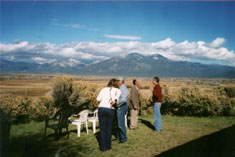
Visitors looking north across the McCarthy Ranch from
a neighbor's house
An advisory board for Friends of the McCarthy Ranch is
being established, and a capital campaign to raise the
necessary $1 million down payment has begun. The Taos
Community Foundation has agreed to accept donations for the
fund raising effort and will apply for grants and provide
administrative support. The American Farm Land Trust has
agreed to accept donations for the land and hold them in
escrow and return them if the necessary funding is not
achieved in time to purchase the ranch (it is currently
listed in the real estate market). The strategy is to
generate private donations that can be matched with loans or
donations from trusts and foundations. A portion of the
ranch would be devoted to a nature preserve and grass bank,
where local ranchers could graze their livestock while their
pastures are rehabilitated. Wool Traditions would manage
about 15 acres for the educational center. Hopefully, income
from the operations would at some point be sufficient to
support the center and contribute to the stewardship of the
ranch lands. A conservation easement would be developed to
insure the long term agricultural use of the ranch and to
limit the scale of development at the center.
For more information regarding the project or if you are
interested in making a donation, call John Bosshard at 505
758-9638 or Mark Shuetz at 505 751-4314.
New Mexico Community-Based
Forestry Alliance
The News Mexico Community-Based Forestry Alliance is
recruiting community forestry groups and other interested
New Mexicans to join the Alliance as it moves forward to
formalize the organization. The Alliance is a state-wide
coalition of foresters working to provide economic,
environmental, and social benefits to their communities
through forest restoration projects. Over the course of the
next few months the group will establish a steering
committee and consult with forest adjacent communities, the
Forest Service, and Bureau of Land Management to determine
potential forest restoration projects and urban/ interface
projects that the Alliance can contract for next year.
Michael Quintana will be contacting forestry groups that
have already been involved in the Alliance and recruiting
potential members to provide updated information regarding
the Alliance and to gather information on current
restoration activities. If you would like more information
regarding the Alliance please contact him at 505 577-2924 or
Max Córdova of La Montaña de Truchas at 505
689-2686.
Who's
Reading La Jicarita News?

Jim Dunlap of Allá Latin American Books and
Chellis Glendinning
La Jicarita News would like to thank all of you who
sent in subscriptions, donations, and kind words - with a
special thanks to the Healy Foundation. We'll be back for
2003.
|













